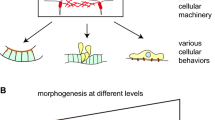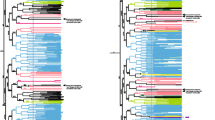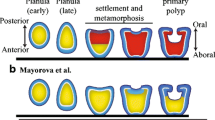Abstract
The stalked jellyfish (Staurozoa) is an extraordinary clade within medusozoan cnidarians in which the medusa is attached to the substrate unlike the pelagic jellyfishes which compose the rest of the medusozoans. Along with this remarkable feature, staurozoans are characterized by an extremely low number of cells (< 100) in the embryos and larvae. The aim of the present study is to explore early development of the staurozoan Lucernaria quadricornis and to elucidate morphogenetic events evolved to overcome the constraints imposed by low cell number. Using bright field, confocal, and electron microscopy, we create a normal table of development of Lucernaria, describe cell number dynamics, and visualize organization of embryos and larvae. From these data, we infer a crosstalk between cell reshaping, cell rearrangement, and mechanical stress, involved in gastrulation, anterior-posterior axis differentiation, and even locomotion of the larva. Our work also demonstrates that staurozoans convergently developed morphogenetic pathways similar to other very distant animals with low cell number in the early development. We consider Lucernaria as an EvoDevo model with potential for further research to answer the question of how evolutionary forces act on developmental trajectories.












Similar content being viewed by others
Data Availability
all data generated or analyzed during this study are included in this published article; original images generated in the course of light, confocal, and electron microscopy studies are available by request.
References
Aboobaker, A., & Blaxter, M. (2010). The nematode story: Hox gene loss and rapid evolution. In J. S. Deutsch (Ed.), Hox genes. Advances in experimental medicine and biology (pp. 101–110). Springer. https://doi.org/10.1007/978-1-4419-6673-5_7.
Adams, D. S., Keller, R., & Koehl, M. A. (1990). The mechanics of notochord elongation, straightening and stiffening in the embryo of Xenopus laevis. Development (Cambridge, England), 110(1), 115–130. https://doi.org/10.1093/icb/40.1.53.
Beloussov, L. V. (1996). Patterns of mechanical stresses and formation of the body plans in animal embryos. Verhandlungen der Deutschen Zoologischen Gesellschaft, 89, 219–229.
Bergh, R. S. (1888). Bemaerkninger om Udviklingen af Lucernaria. Vidensk Meddel Naturhist Foren Kjøbenhavn, 1888, 214–220.
Berrill, N. J. (1949). Developmental analysis of Scyphomedusae. Biological Reviews, 24(4), 393–409. https://doi.org/10.1111/j.1469-185X.1949.tb00581.x.
Blankenship, J. T., Backovic, S. T., Sanny, J. S. P., Weitz, O., & Zallen, J. A. (2006). Multicellular rosette formation links planar cell polarity to tissue morphogenesis. Developmental Cell, 11(4), 459–470. https://doi.org/10.1016/j.devcel.2006.09.007.
Blumenthal, T., Davis, P., & Garrido-Lecca, A. (2005). Operon and non-operon gene clusters in the C. elegans genome. In WormBook. https://doi.org/10.1895/wormbook.1.175.1.
Boelsterli, U. (1977). An electron microscopic study of early developmental stages, myogenesis, oogenesis and cnidogenesis in the anthomedusa, Podocoryne carnea M. Sars. Journal of Morphology, 154(2), 259–289. https://doi.org/10.1002/jmor.1051540206.
Boero, F., Bouillon, J., & Piraino, S. (1992). On the origins and evolution of hydromedusan life cycles (Cnidaria, Hydrozoa). Sex Origin and Evolution, 6, 59–68.
Burggren, W. W., & Reyna, K. S. (2011). Developmental trajectories, critical windows and phenotypic alteration during cardio-respiratory development. Respiratory Physiology & Neurobiology, 178(1), 13–21. https://doi.org/10.1016/j.resp.2011.05.001.
Burmistrova, Y. A., Osadchenko, B. V., Bolshakov, F. V., Kraus, Y. A., & Kosevich, I. A. (2018). Embryonic development of thecate hydrozoan Gonothyraea loveni (Allman, 1859). Development, Growth & Differentiation, 60(8), 483–501. https://doi.org/10.1111/dgd.12567.
Byrum, C. A. (2001). An analysis of hydrozoan gastrulation by unipolar ingression. Developmental Biology, 240(2), 627–640. https://doi.org/10.1006/dbio.2001.0484.
Carrière, Y., & Roff, D. A. (1995). The evolution of offspring size and number: a test of the Smith-Fretwell model in three species of crickets. Oecologia, 102(3), 389–396. https://doi.org/10.1007/BF00329806.
Chin-Sang, I. D., & Chisholm, A. D. (2000). Form of the worm: genetics of epidermal morphogenesis in C. elegans. Trends in Genetics, 16(12), 544–551. https://doi.org/10.1016/S0168-9525(00)02143-0.
Clark, A. G., Wartlick, O., Salbreux, G., & Paluch, E. K. (2014). Stresses at the cell surface during animal cell morphogenesis. Current Biology, 24(10), R484–R494. https://doi.org/10.1016/j.cub.2014.03.059.
Clark, E. (2017). Dynamic patterning by the Drosophila pair-rule network reconciles long-germ and short-germ segmentation. PLoS Biology, 15(9), e2002439. https://doi.org/10.1371/journal.pbio.2002439.
Collins, A., Schuchert, P., Marques, A., Jankowski, T., Medina, M., & Schierwater, B. (2006). Medusozoan phylogeny and character evolution clarified by new large and small subunit rDNA data and an assessment of the utility of phylogenetic mixture models. Systematic Biology, 55(1), 97–115. https://doi.org/10.1080/10635150500433615.
Denoeud, F., Henriet, S., Mungpakdee, S., Aury, J. M., Da Silva, C., Brinkmann, H., Mikhaleva, J., Olsen, L. C., Jubin, C., Cañestro, C., Bouquet, J. M., Danks, G., Poulain, J., Campsteijn, C., Adamski, M., Cross, I., Yadetie, F., Muffato, M., Louis, A., et al. (2010). Plasticity of animal genome architecture unmasked by rapid evolution of a pelagic tunicate. Science, 330(6009), 1381–1385. https://doi.org/10.1126/science.1194167.
Fujii, S., Nishio, T., & Nishida, H. (2008). Cleavage pattern, gastrulation, and neurulation in the appendicularian, Oikopleura dioica. Development Genes and Evolution, 218(1–2), 69–79. https://doi.org/10.1007/s00427-008-0205-4.
Gardiner, S. L., & Rieger, R. M. (1980). Rudimentary cilia in muscle cells of annelids and echinoderms. Cell and Tissue Research, 213(2), 247–252. https://doi.org/10.1007/BF00234785.
Gudipaty, S. A., Lindblom, J., Loftus, P. D., Redd, M. J., Edes, K., Davey, C. F., Krishnegowda, V., & Rosenblatt, J. (2017). Mechanical stretch triggers rapid epithelial cell division through Piezo1. Nature, 543(7643), 118–121. https://doi.org/10.1038/nature21407.
Haas, P. A., Höhn, S. S. M. H., Honerkamp-Smith, A. R., Kirkegaard, J. B., & Goldstein, R. E. (2018). The noisy basis of morphogenesis: mechanisms and mechanics of cell sheet folding inferred from developmental variability. PLoS Biology, 16(7), e2005536. https://doi.org/10.1371/journal.pbio.2005536.
Hanaoka, K.-I. (1934). Notes on the early development of a stalked medusa. In Proceedings of the Imperial Academy (Vol. 10, pp. 117–120). https://doi.org/10.2183/pjab1912.10.117.
Hejnol, A. (2010). A twist in time-the evolution of spiral cleavage in the light of animal phylogeny. Integrative and Comparative Biology, 50(5), 695–706. https://doi.org/10.1093/icb/icq103.
Holland, L. Z. (2014). Genomics, evolution and development of amphioxus and tunicates: the Goldilocks principle. Journal of Experimental Zoology Part B: Molecular and Developmental Evolution, 324(4), 342–352. https://doi.org/10.1002/jez.b.22569.
Ikuta, T., & Saiga, H. (2005). Organization of Hox genes in ascidians: present, past, and future. Developmental Dynamics, 233(2), 382–389. https://doi.org/10.1002/dvdy.20374.
Ivanova-Kazas, O. M. (1995). Evolutionary embryology of animals. In Evolutionary embryology of animals. St. Petersburg, Nauka.
Jeffery, W. R. (1992). A gastrulation center in the ascidian egg. Development, 116(S), 53–63.
Kalinka, A. T., & Tomancak, P. (2012). The evolution of early animal embryos: conservation or divergence? Trends in Ecology & Evolution, 27(7), 385–393. https://doi.org/10.1016/j.tree.2012.03.007.
Keller, R., Davidson, L., Edlund, A., Elul, T., Ezin, M., Shook, D., & Skoglund, P. (2000). Mechanisms of convergence and extension by cell intercalation. Philosophical Transactions of the Royal Society, B: Biological Sciences, 355(1399), 897–922. https://doi.org/10.1098/rstb.2000.0626.
Kowalevsky, A. (1884). Zur Entwicklungsgeschichte der Lucernaria. Zoologischer Anzeiger, 7, 712–717.
Kraus, Y. A. (2006). Morphomechanical programming of morphogenesis in Cnidarian embryos. International Journal of Developmental Biology, 50(2–3), 267–275. https://doi.org/10.1387/ijdb.052061yk.
Kraus, Y., Chevalier, S., & Houliston, E. (2020). Cell shape changes during larval body plan development in Clytia hemisphaerica. Developmental Biology, 468(1–2), 59–79. https://doi.org/10.1016/j.ydbio.2020.09.013.
Kraus, Y. A., Flici, H., Hensel, K., Plickert, G., Leitz, T., & Frank, U. (2014). The embryonic development of the cnidarian Hydractinia echinata. Evolution and Development, 16(6), 323–338. https://doi.org/10.1111/ede.12100.
Kraus, Y. A., & Markov, A. V. (2017). The gastrulation in Cnidaria: a key to understanding phylogeny or the chaos of secondary modifications? Biology Bulletin Reviews, 7(1), 7–25. https://doi.org/10.1134/s2079086417010029.
Kraus, Y. A., & Technau, U. (2006). Gastrulation in the sea anemone Nematostella vectensis occurs by invagination and immigration: an ultrastructural study. Development Genes and Evolution, 216(3), 119–132. https://doi.org/10.1007/s00427-005-0038-3.
Lambert, J. D. (2010). Developmental patterns in spiralian embryos. Current Biology, 20(2), R72–R77. https://doi.org/10.1016/j.cub.2009.11.041.
Leclère, L., Copley, R. R., Momose, T., & Houliston, E. (2016). Hydrozoan insights in animal development and evolution. Current Opinion in Genetics and Development, 39, 157–167. https://doi.org/10.1016/j.gde.2016.07.006.
Lecuit, T., & Lenne, P. F. (2007). Cell surface mechanics and the control of cell shape, tissue patterns and morphogenesis. Nature Reviews Molecular Cell Biology, 8(8), 633–644. https://doi.org/10.1038/nrm2222.
Liu, M., Xu, J., Tanswell, A. K., & Post, M. (1993). Stretch-induced growth-promoting activities stimulate fetal rat lung epithelial cell proliferation. Experimental Lung Research, 19, 505–517.
Lynch, J. A., El-Sherif, E., & Brown, S. J. (2012). Comparisons of the embryonic development of Drosophila, Nasonia, and Tribolium. Wiley Interdisciplinary Reviews: Developmental Biology, 1(1), 16–39. https://doi.org/10.1002/wdev.3.
Metschnikoff, E. (1886). Embryologische Studien an Medusen. In A. Holder & E. Metschnikoff (Eds.), Ein Beitrag zur Genealogie der Primitiv-organe. https://doi.org/10.5962/bhl.title.5982.
Miranda, L. S., Hirano, Y. M., Mills, C. E., Falconer, A., Fenwick, D., Marques, A. C., & Collins, A. G. (2016). Systematics of stalked jellyfishes (Cnidaria: Staurozoa). PeerJ, 4, e1951. https://doi.org/10.7717/peerj.1951.
Miranda, L. S., Mills, C. E., Hirano, Y. M., Collins, A. G., & Marques, A. C. (2018). A review of the global diversity and natural history of stalked jellyfishes (Cnidaria, Staurozoa). Marine Biodiversity, 48, 1695–1714. https://doi.org/10.1007/s12526-017-0721-4.
Momose, T., & Schmid, V. (2006). Animal pole determinants define oral-aboral axis polarity and endodermal cell-fate in hydrozoan jellyfish Podocoryne carnea. Developmental Biology, 292(2), 371–380. https://doi.org/10.1016/j.ydbio.2006.01.012.
Nishida, H. (1986). Cell division pattern during gastrulation of the ascidian, Halocynthia roretzi (cell division pattern/gastrulation/neurulation/ascidian embryo). Development, Growth & Differentiation, 28(2), 191–201. https://doi.org/10.1111/j.1440-169X.1986.00191.x.
Otto, J. J. (1976). Early development and planula movement in Haliclystus (Scyphozoa: Stauromedusae). In G. O. Mackie (Ed.), Coelenterate ecology and behavior (pp. 319–329). Springer. https://doi.org/10.1007/978-1-4757-9724-4_34.
Paps, J., Holland, P. W. H., & Shimeld, S. M. (2012). A genome-wide view of transcription factor gene diversity in chordate evolution: less gene loss in amphioxus? Briefings in Functional Genomics, 11(2), 177–186. https://doi.org/10.1093/bfgp/els012.
Pettitt, J., Philippe, L., Sarkar, D., Johnston, C., Gothe, H. J., Massie, D., Connolly, B., & Müller, B. (2014). Operons are a conserved feature of nematode genomes. Genetics, 197(4), 1201–1211. https://doi.org/10.1534/genetics.114.162875.
Plickert, G., Kroiher, M., & Munck, A. (1988). Cell proliferation and early differentiation during embryonic development and metamorphosis of Hydractinia echinata. Development, 103(4), 795–803.
Polilov, A. A. (2015). Small is beautiful: features of the smallest insects and limits to miniaturization. Annual Review of Entomology, 60, 103–121. https://doi.org/10.1146/annurev-ento-010814-020924.
Polilov, A. A. (2016). At the size limit-effects of miniaturization in insects. In At the size limit-effects of miniaturization in insects. Springer. https://doi.org/10.1007/978-3-319-39499-2.
Priess, J., & Hirsh, D. I. (1986). Caenorhabditis elegans morphogenesis: the role of the cytoskeleton in elongation of the embryo. Developmental Biology, 117(1), 156–173. https://doi.org/10.1016/0012-1606(86)90358-1.
Raff, R. A. (1992). Evolution of developmental decisions and morphogenesis: the view from two camps. Development, 116(S), 15–22.
Raikova, E. V. (1990). Fine structure of the nematocytes of Polypodium hydriforme Ussov (Cnidaria). Zoologica Scripta, 19(1), 1–11. https://doi.org/10.1111/j.1463-6409.1990.tb00236.x.
Rieger, R. M., & Lombardi, J. (1987). Ultrastructure of coelomic lining in echinoderm podia: significance for concepts in the evolution of muscle and peritoneal cells. Zoomorphology, 107(4), 191–208. https://doi.org/10.1007/BF00312261.
Rifkin, J. F., & Endean, R. (1988). Arrangement of accessory cells and nematocytes bearing mastigophores in the tentacles of the cubozoan Chironex fleckeri. Journal of Morphology, 195(1), 103–115. https://doi.org/10.1002/jmor.1051950110.
Roh-Johnson, M., Shemer, G., Higgins, C. D., McClellan, J. H., Werts, A. D., Tulu, U. S., Gao, L., Betzig, E., Kiehart, D. P., & Goldstein, B. (2012). Triggering a cell shape change by exploiting preexisting actomyosin contractions. Science, 335(6073), 1232–1235. https://doi.org/10.1126/science.1217869.
Rosenheim, J. A. (1996). An evolutionary argument for egg limitation. Evolution, 50(5), 2089–2094. https://doi.org/10.1111/j.1558-5646.1996.tb03595.x.
Salbreux, G., Charras, G., & Paluch, E. (2012). Actin cortex mechanics and cellular morphogenesis. Trends in Cell Biology, 22(10), 536–545. https://doi.org/10.1016/j.tcb.2012.07.001.
Satou, Y., Mineta, K., Ogasawara, M., Sasakura, Y., Shoguchi, E., Ueno, K., Yamada, L., Matsumoto, J., Wasserscheid, J., Dewar, K., Wiley, G. B., Macmil, S. L., Roe, B. A., Zeller, R. W., Hastings, K. E. M., Lemaire, P., Lindquist, E., Endo, T., Hotta, K., & Inaba, K. (2008). Improved genome assembly and evidence-based global gene model set for the chordate Ciona intestinalis: new insight into intron and operon populations. Genome Biology, 9(10), R152. https://doi.org/10.1186/gb-2008-9-10-r152.
Sawyer, J. M., Harrell, J. R., Shemer, G., Sullivan-Brown, J., Roh-Johnson, M., & Goldstein, B. (2010). Apical constriction: a cell shape change that can drive morphogenesis. Developmental Biology, 341(1), 5–19. https://doi.org/10.1016/j.ydbio.2009.09.009.
Schierenberg, E. (2001). Three sons of fortune: early embryogenesis, evolution and ecology of nematodes. BioEssays, 23(9), 841–847. https://doi.org/10.1002/bies.1119.
Schierenberg, E. (2006). Embryological variation during nematode development. In J. Priess & G. Seydoux (Eds.), WormBook. https://doi.org/10.1895/wormbook.1.55.1.
Schulze, J., & Schierenberg, E. (2011). Evolution of embryonic development in nematodes. EvoDevo, 2(1), 18. https://doi.org/10.1186/2041-9139-2-18.
Seo, H. C., Edvardsen, R. B., Maeland, A. D., Bjordal, M., Jensen, M. F., Hansen, A., Flaat, M., Weissenbach, J., Lehrach, H., Reinhardt, R., & Chourrout, D. (2004). Hox cluster disintegration with persistent anteroposterior order of expression in Oikopleura dioica. Nature, 431, 67–71. https://doi.org/10.1038/nature02709.
Sherrard, K., Robin, F., Lemaire, P., & Munro, E. (2010). Sequential activation of apical and basolateral contractility drives ascidian endoderm invagination. Current Biology, 20(17), 1499–1510. https://doi.org/10.1016/j.cub.2010.06.075.
Shook, D. R., Kasprowicz, E. M., Davidson, L. A., & Keller, R. (2018). Large, long range tensile forces drive convergence during Xenopus blastopore closure and body axis elongation. ELife, 7, e26944. https://doi.org/10.7554/eLife.26944.
Shook, D. R., & Keller, R. (2003). Mechanisms, mechanics and function of epithelial-mesenchymal transitions in early development. Mechanisms of Development, 120(11), 1351–1383. https://doi.org/10.1016/j.mod.2003.06.005.
Shook, D. R., & Keller, R. (2008). Morphogenic machines evolve more rapidly than the signals that pattern them: lessons from amphibians. Journal of Experimental Zoology Part B: Molecular and Developmental Evolution, 310(1), 111–135. https://doi.org/10.1002/jez.b.21204.
Simske, J. S., & Hardin, J. (2001). Getting into shape: epidermal morphogenesis in Caenorhabditis elegans embryos. BioEssays, 23(1), 12–23. https://doi.org/10.1002/1521-1878(200101)23:1<12::AID-BIES1003>3.0.CO;2-R.
Smith, F. J., Percival, C. J., Young, N. M., Hu, D., Schneider, R. A., Marcucio, R. S., & Hallgrimsson, B. (2015). Divergence of craniofacial developmental trajectories among avian embryos. Developmental Dynamics, 244(9), 1158–1167. https://doi.org/10.1002/dvdy.24262.
Strathmann, R. R., Staver, J. M., & Hoffman, J. R. (2002). Risk and the evolution of cell-cycle durations of embryos. Evolution, 56(4), 708–720. https://doi.org/10.1111/j.0014-3820.2002.tb01382.x.
Sulston, J. E., Schierenberg, E., White, J. G., & Thomson, J. N. (1983). The embryonic cell lineage of the nematode Caenorhabditis elegans. Developmental Biology, 100(1), 64–119. https://doi.org/10.1016/0012-1606(83)90201-4.
Thomas, K. A., & Stemple, D. L. (2004). Development of the zebrafish organizer and notochord. In Z. Gong & V. Korzh (Eds.), Fish development and genetics (pp. 87–120). World Scientific. https://doi.org/10.1142/9789812565761_0003.
Tsagkogeorga, G., Cahais, V., & Galtier, N. (2012). The population genomics of a fast evolver: high levels of diversity, functional constraint, and molecular adaptation in the tunicate Ciona intestinalis. Genome Biology and Evolution, 4(8), 852–861. https://doi.org/10.1093/gbe/evs054.
van der Sande, M., Kraus, Y. A., Houliston, E., & Kaandorp, J. (2020). A cell-based boundary model of gastrulation by unipolar ingression in the hydrozoan cnidarian Clytia hemisphaerica. Developmental Biology, 460(2), 176–186. https://doi.org/10.1016/j.ydbio.2019.12.012.
van de Vyver, G. (1964). Etude histologique du developpement d’Hydractinia echinata. Cahiers de Biologie Marine, 5, 295–310.
Westfall, J. A. (1966). The differentiation of nematocysts and associated structures in the cnidaria. Zeitschrift für Zellforschung und Mikroskopische Anatomie, 75(2), 381–403. https://doi.org/10.1007/BF00336871.
Wietrzykowski, W. (1910). Sur le développement des Lucernaridés (note préliminaire). Archives de Zoologie Expérimentale, 5, 10–27.
Wietrzykowski, W. (1912). Recherches sur le developpement des Lucernaires. Archives de Zoologie Expérimentale et Générale, 10, 1–95.
Wray, G. A., & Raff, R. A. (1991). The evolution of developmental strategy in marine invertebrates. Trends in Ecology & Evolution, 45, 1741–1750. https://doi.org/10.1016/0169-5347(91)90121-D.
Yuan, D., Nakanishi, N., Jacobs, D. K., & Hartenstein, V. (2008). Embryonic development and metamorphosis of the scyphozoan Aurelia. Development Genes and Evolution, 218(10), 525–539. https://doi.org/10.1007/s00427-008-0254-8.
Acknowledgments
We thank N.A. Pertsov White Sea Biological Station of Moscow State University for the help and support in obtaining samples and providing access to all required facilities and equipment of the “Center of Microscopy WSBS MSU”. We are very grateful to the Shared Facilities center “Electron Microscopy for Life Sciences” of the Lomonosov Moscow State University for the possibility to perform TEM. We want to express special gratitude to Catriona Munro (Collège de France, Center for Interdisciplinary Research in Biology) and members of the Villefranche-sur-mer Developmental Biology Laboratory for manuscript critical reading and advice. The authors thank Brigit Shea Sullivan, NIH Library Editing Service, for manuscript editing assistance.
Funding
This study was funded by the Russian Foundation for Basic Research (grant # 15-04-08214-а) and by the Governmental Basic Research Program for the Koltzov Institute of Developmental Biology of the Russian Academy of Sciences (0108-2019-0003).
Author information
Authors and Affiliations
Contributions
Y.K. and T.M. designed the research; T.M., B.O., and Y.K. performed the in vivo and TEM studies; T.M. and Y.K. performed confocal microscopy; T.M. and Y.K. analyzed the data and wrote the paper.
Corresponding authors
Ethics declarations
Conflict of interest
The authors declare that they have no conflict of interest.
Ethics approval
Not applicable.
Consent to participate
Not applicable.
Consent for publication
Not applicable.
Code availability
Not applicable.
Additional information
Publisher’s note
Springer Nature remains neutral with regard to jurisdictional claims in published maps and institutional affiliations.
Rights and permissions
About this article
Cite this article
Mayorova, T.D., Osadchenko, B. & Kraus, Y. How to build a larval body with less than a hundred cells? Insights from the early development of a stalked jellyfish (Staurozoa, Cnidaria). Org Divers Evol 20, 681–699 (2020). https://doi.org/10.1007/s13127-020-00459-8
Received:
Accepted:
Published:
Issue Date:
DOI: https://doi.org/10.1007/s13127-020-00459-8




